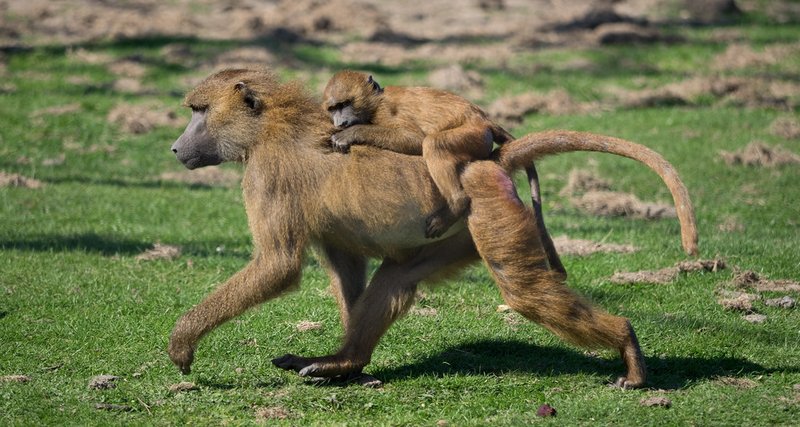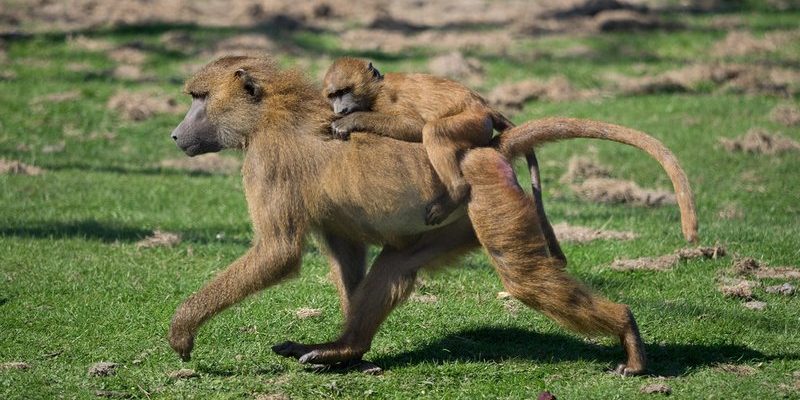
The Guinea baboon is quite the character in the world of primates! Imagine a furry, gregarious creature with a lively personality that thrives in the heart of the African savanna. These fascinating animals are part of a larger baboon family, known for their striking appearance, complex social behavior, and adaptability. They’re not just any old primate; they’ve got a flair for being both intelligent and quirky.
You might picture them lounging in the sun or bounding through grasslands, but there’s so much more beneath the surface. From their habitat to their diets and social dynamics, the Guinea baboon has a life that’s as complex as it is intriguing. If you’re curious about what makes these baboons tick, you’re in for a treat. Let’s dive into the world of the Guinea baboon and explore everything from their lifestyle to their unique traits.
What is a Guinea Baboon?
The Guinea baboon (Papio papio), also known as the western baboon, is known for its robust body and long limbs. They typically weigh between 40 to 70 pounds, making them one of the larger baboon species. Their fur is mostly brownish-tan, with some variations, and their faces have a distinct, expressive look that can range from serious to playful. You could say they wear their emotions right on their faces!
These baboons are primarily found in the wooded areas and savannas of West Africa, particularly in countries like Guinea, Senegal, and Mali. They have adapted well to their environment, often foraging for food and living in large social groups known as “troops.” In these troops, they exhibit fascinating social hierarchies and bonds, often displaying behaviors that show empathy and cooperation.
Physical Characteristics
When it comes to physical traits, the Guinea baboon has some standout features. Their long limbs and powerful muscles enable them to move easily through their environment, whether they’re climbing trees or running across the ground. Their tails, which are long and used for balance, help them maintain agility, especially when navigating rocky terrains or treetops.
One of the most intriguing aspects of Guinea baboons is their facial features. They have a pronounced muzzle, which gives them an expressive countenance that can communicate a range of emotions. This ability to convey feelings is key to their social interactions. Their bright eyes and various facial expressions make it easier for them to bond with other members of their troop, reinforcing social connections.
Diet and Feeding Habits
The diet of the Guinea baboon is quite diverse, which helps them thrive in varied environments. They are omnivorous, meaning they enjoy a mix of plant and animal food. Typically, their meals consist of fruits, leaves, seeds, and flowers, but they’re not above snacking on small insects or even small mammals when the opportunity arises. It’s like they have a buffet of options at their disposal!
These baboons are known for their foraging skills, often traveling in groups to find food. They use their strong sense of smell and keen eyesight to spot ripe fruits or other edible goodies. The social aspect of feeding is also vital; you’ll often see them grooming each other while eating, which helps strengthen their social bonds and create a sense of community within the troop.
Habitat and Distribution
Guinea baboons prefer habitats that offer a mix of open grasslands and areas with trees, providing them with both food and shelter. They tend to stay close to water sources, which are crucial for their survival. In the wild, you can find these baboons in countries like Senegal, Guinea, and Sierra Leone, where they roam freely in their natural environments.
As they navigate through their habitats, Guinea baboons display remarkable adaptability. They can thrive in both dry and wet seasons, depending on food availability. During the dry season, they usually stick to areas with more permanent water sources, while in the wet season, they might venture into more open fields for the bounty of fresh fruits and vegetation. This flexibility helps them survive in a variety of conditions.
Social Structure and Behavior
Guinea baboons are highly social animals, living in troops that can vary in size from a few dozen to over a hundred individuals. Within these troops, a complex social structure forms. Each troop typically has a dominant male, but females play a critical role in maintaining social bonds and hierarchies. In fact, female baboons often form strong alliances with one another, which can influence their standing in the troop.
Their social interactions are rich and varied. They communicate through a series of vocalizations, facial expressions, and body language. Grooming is a significant part of their social behavior—it’s not just about hygiene; it’s a bonding activity that reinforces connections between individuals. Imagine a group of friends laughing and chatting while sharing snacks; that’s kind of what grooming is for them!
Reproduction and Lifespan
When it comes to reproduction, Guinea baboons have a fascinating cycle. Mating usually happens throughout the year, but females do have a specific breeding season. After a gestation period of about six months, females typically give birth to a single baby, although twins can occur on rare occasions. The baby baboons are incredibly cute and clumsy, often seen clinging to their mothers for support as they learn about their world.
The young baboons grow rapidly and are weaned by the time they’re about six months old, but they usually stay with their mothers for up to two years, learning valuable survival skills along the way. In the wild, Guinea baboons can live up to 30 years, but predators and environmental threats can shorten their lives significantly. This is where the strong social structure of their troops comes into play, offering support and protection to their young.
Threats and Conservation
Unfortunately, like many wild animals, Guinea baboons face various threats. Habitat loss due to agriculture, deforestation, and human encroachment poses significant risks to their populations. Additionally, they can sometimes come into conflict with farmers, leading to negative perceptions of these animals. It’s a challenging situation, as both humans and baboons require space to thrive.
Conservation efforts are crucial to ensuring the survival of the Guinea baboon. Various organizations work toward promoting awareness and protecting their habitats. Tools like wildlife reserves and national parks have been established in some regions, helping to create safe spaces for these primates. Education is also key; teaching local communities about the ecological roles of baboons can foster coexistence rather than conflict.
Interesting Facts About Guinea Baboons
| Scientific Name: | Papio papio |
| Average Weight: | 40-70 pounds |
| Diet: | Omnivorous (fruits, leaves, insects) |
| Habitat: | Wooded savannas of West Africa |
| Gestation Period: | Approximately 6 months |
| Lifespan: | Up to 30 years in the wild |
| Social Structure: | Hierarchical troops |
The Guinea baboon is more than just a fascinating primate; it’s a remarkable example of how wildlife adapts and thrives in the face of challenges. Their complex social structures, playful nature, and adaptability to different environments make them a captivating study. By learning about these creatures, we not only gain insight into their lives but also understand the importance of protecting their habitats and ensuring their survival. After all, every baboon has a story worth telling, and by sharing those stories, we can help preserve their place in the world.
FAQ
Where can you find Guinea baboons in the wild?
Guinea baboons are primarily found in the wooded savannas of West Africa. They inhabit countries such as Guinea, Senegal, and Mali, often living in areas close to water sources. Their preference for mixed environments allows them to thrive where there are both food and shelter options available.
What do Guinea baboons eat?
Guinea baboons are omnivores and have a varied diet that includes fruits, leaves, seeds, and flowers. They also eat insects and occasionally small mammals. This diverse diet helps them gather the necessary nutrients to thrive in their environment.
How do Guinea baboons communicate?
Communication among Guinea baboons is complex and involves vocalizations, facial expressions, and body language. They use these methods to convey emotions, warn of danger, or signal the presence of food. Grooming is another form of communication that strengthens bonds within the troop.
Are Guinea baboons social animals?
Absolutely! Guinea baboons are highly social animals that live in troops of varying sizes. Within these groups, they display a range of social behaviors, maintaining hierarchies and forming strong bonds with one another. Their social interactions are vital for their survival and well-being.
What is the lifespan of a Guinea baboon in the wild?
In the wild, Guinea baboons can live up to 30 years, but this lifespan can be affected by factors such as predation and habitat loss. In captivity, with the right care and environment, they may live even longer.
How do Guinea baboons raise their young?
Female Guinea baboons typically give birth to a single baby after a gestation period of about six months. Mothers care for their young, often keeping them close for up to two years as they learn essential survival skills. This parental care is critical for the young baboon’s development.
What threats do Guinea baboons face today?
Guinea baboons face several threats, primarily due to habitat loss from agriculture and deforestation. Conflicts with humans, especially when they raid crops, can lead to negative perceptions of these animals. Conservation efforts are essential to protect their habitats and promote coexistence.
What is the social structure of a Guinea baboon troop like?
Guinea baboon troops have a hierarchical social structure, usually led by a dominant male. However, female baboons also play essential roles in maintaining social bonds within the troop. Grooming and other social interactions help reinforce their relationships and establish social order.
How do Guinea baboons adapt to their environment?
Guinea baboons are highly adaptable animals. They can thrive in both dry and wet seasons by changing their foraging habits and habitat preferences based on food availability. This adaptability enables them to survive in varied environments, which is crucial for their continued existence.
Are Guinea baboons endangered?
While Guinea baboons are not currently considered endangered, they face several challenges that threaten their populations. Habitat destruction and human-wildlife conflict can impact their numbers, making conservation efforts critical to ensuring their long-term survival.
Can Guinea baboons be kept as pets?
Keeping Guinea baboons as pets is generally not advisable. They are wild animals with complex social needs and require specialized care that most people cannot provide. Moreover, in many places, it is illegal to keep primates as pets, so it’s best to appreciate these fascinating creatures in their natural habitats.

